When choosing milling machine(CNC Router) decide:
1. What material are you going to work with. The requirements for the rigidity of the design of the milling machine and its type depend on this.
For example, a plywood CNC machine will only process wood (including plywood) and plastics (including composite materials - plastic with foil).
On a milling machine made of aluminum, it is already possible to process non-ferrous metal blanks, while the processing speed of wood products will also increase.
Aluminum milling machines are not suitable for steel processing, massive machines with a cast iron bed are already needed here, while the processing of non-ferrous metals on such milling machines will be more efficient.
2. with the size of the workpieces and the size of the working field of the milling machine. This defines the requirements for the mechanics of a CNC machine.
When choosing a machine, pay attention to studying the mechanics of the machine, the capabilities of the machine depend on its choice, and it is impossible to replace it without a significant alteration of the design!
The mechanics of a CNC milling machine made of plywood and aluminum are often the same. More details below in the text.
But the larger the size of the working field of the machine, the more rigid and expensive linear motion guides will be required for its assembly.
When choosing machines for high-height parts production tasks, there is a common misconception that it is enough to choose a machine with a large Z-travel. But even with a large Z-travel, it is impossible to produce a part with steep slopes if the height of the part is greater than the working length of the cutter, that is, more than 50mm.
Consider the device of a milling machine and options for choosing on the example of CNC machines of the Modelist series.
A) Choice of CNC machine design
There are two options for building CNC machines:
1) designs with movable table, picture 1.
2) design with movable portal, figure 2.

Picture 1Sliding Table Milling Machine
Advantages design of the machine with a movable table - this is ease of implementation, greater rigidity of the machine due to the fact that the portal is fixed and fixed to the frame (base) of the machine.
Flaw- large dimensions compared to the design with a movable portal, and the impossibility of processing heavy parts due to the fact that the movable table carries the part. This design is quite suitable for processing wood and plastics, that is, light materials.
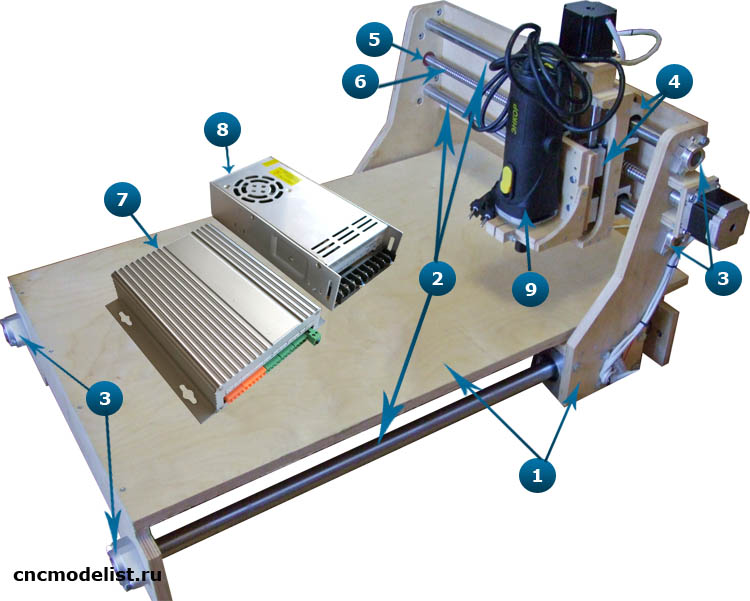
figure 2 Milling machine with a movable portal (gantry machine)
Advantages designs of a milling machine with a movable portal:
Rigid table that can withstand big weight blanks,
Unlimited workpiece length,
compactness,
Possibility of execution of the machine without a table (for example, to install a rotary axis).
Flaws:
Less structural rigidity.
The need to use more rigid (and expensive) guides (due to the fact that the portal "hangs" on the guides, and is not fixed to the rigid frame of the machine, as in the design with a moving table).
B) Choice of mechanics of CNC milling machine
The mechanics are presented (see the numbers in Fig. 1, Fig. 2 and Fig. 3):
3 - guide holders
4 - linear bearings or sleeves
5 - support bearings (for fastening lead screws)
6 - lead screws
10 - coupling for connecting the shaft of the lead screw with the shaft of stepper motors (SM)
12 - running nut
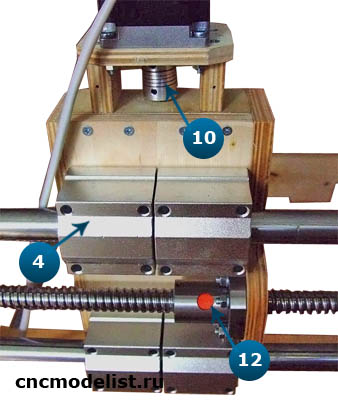
figure 3
Selection of the linear movement system of the milling machine (guides - linear bearings, lead screw - lead nut).
As guides can be used:
1) roller guides, Figure 4.5
Figure 4 
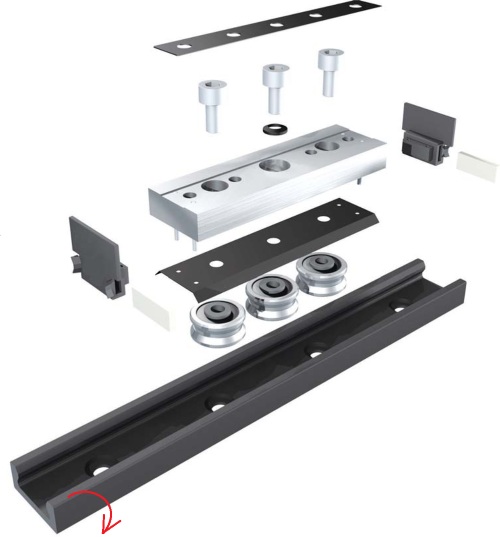
Figure 5
This type of guide has found its way into the designs of amateur lasers and machine tools from the furniture industry, Figure 6

The disadvantage is low load capacity and low resource, since they were not originally intended for use in machines with a large number of movements and high loads, the low strength of the aluminum profile of the guides leads to collapse, Figure 5 and, as a result, an unrecoverable backlash, which makes it unsuitable further use machine.
Another version of roller guides, Figure 7, is also not suitable for high loads and therefore is used only in laser machines.
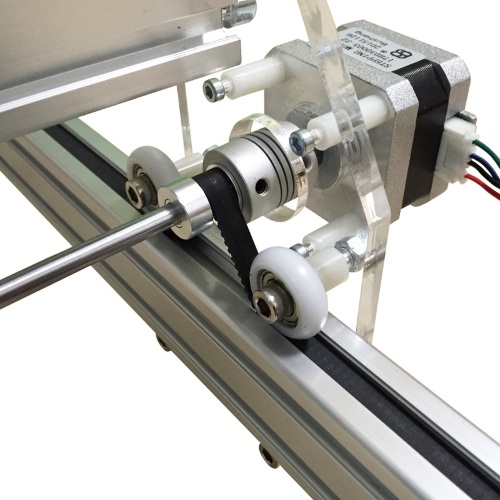
Figure 7
2) round guides, are a steel shaft made of high quality wear-resistant bearing steel with a ground surface, surface hardened and hard chromium plating, shown under the number 2 in figure 2.
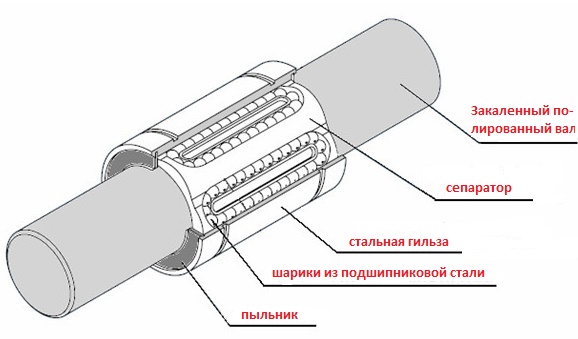
This is the optimal solution for amateur designs, because. Cylindrical guides have sufficient rigidity for processing soft materials when small sizes CNC machine at a relatively low cost. Below is a table for selecting the diameter of cylindrical guides, depending on the maximum length and minimum deflection.
Some Chinese manufacturers of cheap machine tools guides of insufficient diameter, which leads to a decrease in accuracy, for example, when used on an aluminum machine at a working length of 400 mm, guides with a diameter of 16 mm will lead to deflection in the center under its own weight by 0.3..0.5 mm (depending on the weight of the portal).
At right choice shaft diameter, the design of machines with their use is quite strong, the large weight of the shafts gives the structure good stability, overall structural rigidity. On machines larger than a meter, the use of round guides requires a significant increase in diameter to maintain minimum deflection, which makes the use of round guides an unreasonably expensive and heavy solution.
| Axis length | Plywood machine | Aluminum woodworking machine | Aluminum machine for aluminum work | |
| 200mm | 12 | 12 | 16 | 12 |
| 300mm | 16 | 16 | 20 | 16 |
| 400mm | 16 | 20 | 20 | 16 |
| 600mm | 20 | 25 | 30 | 16 |
| 900mm | 25 | 30 | 35 | 16 |
3) profile rail guides
Polished shafts on large machines are being replaced by profile guides. The use of a support along the entire length of the guide allows the use of guides of much smaller diameters. But the use of this type of guides imposes high requirements on the rigidity of the machine's supporting frame, since the beds made of sheet duralumin or sheet steel are not rigid in themselves. The small diameter of rail guides requires the use of a thick-walled steel profiled pipe or a structural aluminum profile of a large section in the design of the machine to obtain the necessary rigidity and bearing capacity machine frame.
The use of a special shape of the profile rail allows for better wear resistance compared to other types of rails.
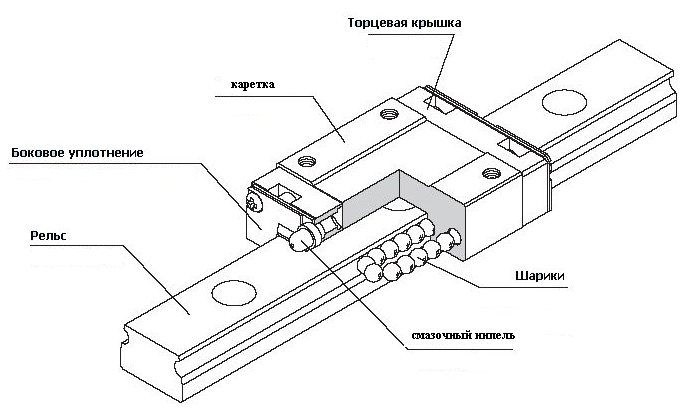
Figure 8
4) Cylindrical guides on a support
Cylindrical guides on a support are a cheaper analogue of profile guides.
As well as profile ones, they require the use in the frame of the machine not sheet materials, and professional pipes of large cross section.
Advantages - no deflection and no spring effect. The price is twice as high as that of cylindrical guides. Their use is justified when the travel length is above 500mm.
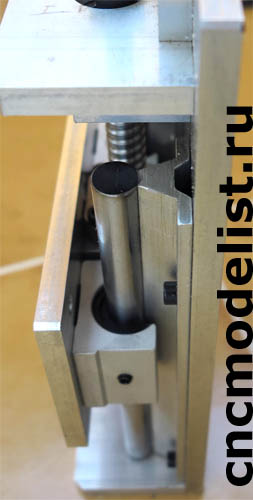
figure 9 Cylindrical guides on a support
The move can be done as bushings(sliding friction) - fig.10 on the left, and using linear bearings(rolling friction)- rice. 10 right.

figure 10 Bushings and linear bearings
The disadvantage of sliding bushings is the wear of the bushings, leading to the appearance of backlash, and the increased effort to overcome sliding friction, requiring the use of more powerful and expensive stepper motors (SM). Their advantage is low price.
Recently, the price of linear bearings has dropped so much that it is economically viable to choose even in inexpensive hobby designs. The advantage of linear bearings is a lower coefficient of friction compared to sleeves, and, accordingly, most of the power of stepper motors goes to useful movements, and not to combat friction, which makes it possible to use motors of lower power.
To convert rotational motion into translational motion on a CNC machine, it is necessary to use a screw gear ( lead screw ). Due to the rotation of the screw, the nut moves forward. In milling and engraving machines can be used sliding screw gears and helical rolling gears .
The disadvantage of a sliding screw gear is a rather large friction, which limits its use at high speeds and leads to wear on the nut.
Sliding screw gears:
1) metric screw. The advantage of a metric screw is its low price. Disadvantages - low accuracy, small step and low speed. The maximum propeller speed (velocity mm`s per min) based on the maximum speed of the stepper motor (600rpm). The best drivers will keep torque up to 900rpm. With this rotation speed, you can get a linear displacement:
For M8 screw (thread pitch 1.25mm) - no more than 750mm/min,
For M10 screw (thread pitch 1.5mm) - 900mm/min,
For M12 screw (thread pitch 1.75mm) - 1050mm/min,
For M14 screw (thread pitch 2.00mm) - 1200mm/min.
At maximum speed, the motor will have about 30-40% of its originally specified torque, and this mode is used exclusively for idle movements.
When working at such a low feed, increased consumption for cutters, after a few hours of work, carbon deposits form on the cutters.
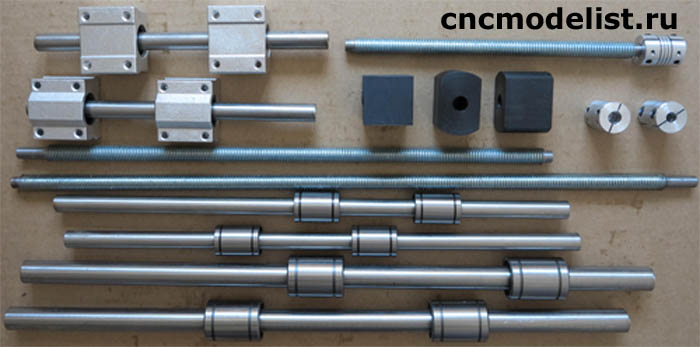
2) trapezoidal screw . In the twentieth century, occupied a leading position in machine tools for metalworking, before the advent of ball screws. Advantage - high accuracy, large thread pitch, and consequently, high speed of movement. Should pay attention to the type of processing than the smoother and Smooth surface screws, the longer the service life of the screw-nut transmission. Rolled screws have an advantage over threaded screws. The disadvantages of the trapezoidal screw-nut transmission are a rather high price compared to a metric screw; sliding friction requires the use of stepper motors of sufficiently high power. The most common screws are TR10x2 (diameter 10mm, thread pitch 2mm), TR12x3 (diameter 12mm, thread pitch 3mm) and TR16x4 (diameter 16mm, thread pitch 4mm). In machine tools, the marking of such a gear TR10x2, TR12x3, TR12x4, TR16x4
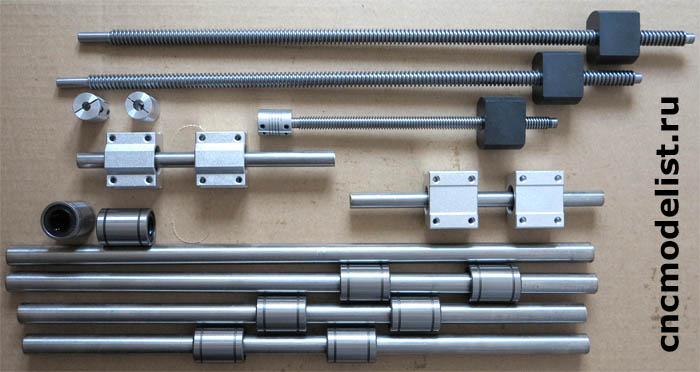
Rolling screw drives:
Ball screw transmission (SVP). In the Ball Screw, sliding friction is replaced by rolling friction. To achieve this, in a ball screw, the screw and nut are separated by balls that roll in the recesses of the screw threads. Recirculation of the balls is ensured by means of return channels that run parallel to the axis of the screw.
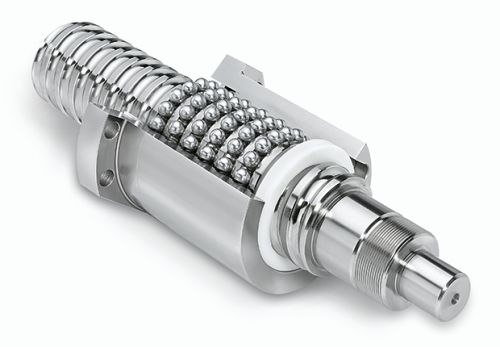
Figure 12
The ball screw provides the ability to work under heavy loads, good running smoothness, significantly increased resource (durability) due to reduced friction and lubrication, increased efficiency (up to 90%) due to less friction. It is capable of operating at high speeds, provides high positioning accuracy, high rigidity and no backlash. That is, machines using ball screws have a much longer resource, but have a higher price. The machines are marked SFU1605, SFU1610, SFU2005, SFU2010, where SFU is a single nut, DFU is a double nut, the first two digits are the screw diameter, the second two are the thread pitch.
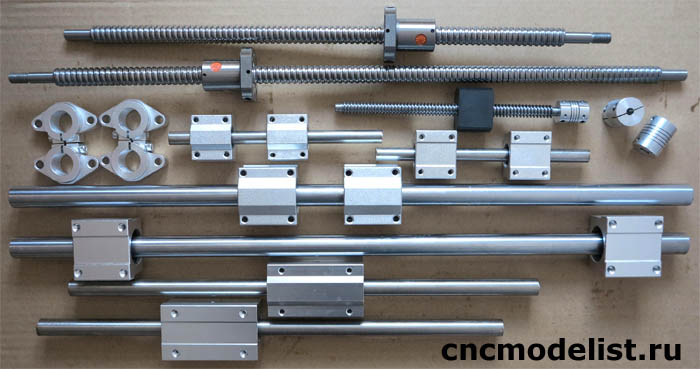
lead screw milling machine can be attached as follows:
1) Design with one support bearing. Fastening is carried out on one side of the screw with a nut to the thrust bearing. The second side of the screw is attached to the stepper motor shaft through a rigid coupling. Advantages - simplicity of design, disadvantage - increased load on the stepper motor bearing.
2) Design with two thrust bearings. The design uses two support bearings in inner sides portal. The disadvantage of the design is a more complicated implementation compared to option 1). The advantage is less vibration if the screw is not perfectly even.
3) Design with two support bearings in tension. The design uses two support bearings on the outer sides of the portal. Advantages - the screw is not deformed, unlike the second option. The disadvantage is a more complex implementation of the design, compared with the first and second options.
Lead nuts there are:
Bronze backlash-free. The advantage of such nuts is durability. Disadvantages - difficult to manufacture (as a result - high price) and have a high coefficient of friction in comparison with caprolon nuts.
Caprolon backlash-free. Currently, caprolon has become widespread and is increasingly replacing metal in professional designs. A running nut made of graphite-filled caprolon has a significantly lower coefficient of friction compared to the same bronze.

figure 14 Lead nut made of graphite-filled caprolon
In the ball screw nut (ball screw), sliding friction is replaced by rolling friction. Advantages - low friction, the ability to work at high speeds. The disadvantage is the high price.

Coupling selection
1) connection using a rigid coupling. Advantages: rigid couplings transmit more torque from shaft to shaft, no backlash under heavy loads. Disadvantages: requires precise installation, as this coupling does not compensate for misalignment and misalignment of the shafts.
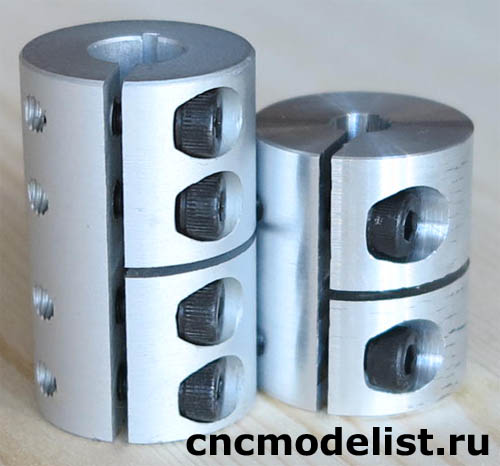
2) connection using a bellows (split) coupling. The advantage of using a bellows coupling is that its use allows you to compensate for misalignment of the installation of the drive shaft and the axis of the stepper motor up to 0.2 mm and misalignment up to 2.5 degrees, resulting in less load on the stepper motor bearing and a longer stepper motor resource. It also allows you to dampen the resulting vibrations.
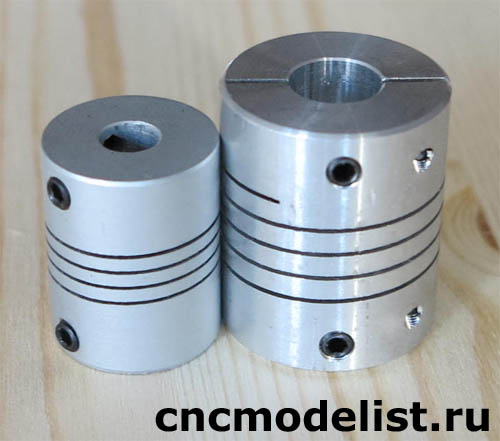
3) connection using a cam clutch. Advantages: allows you to dampen the resulting vibrations, transmit more torque from shaft to shaft, in comparison with a split one. Disadvantages: less misalignment compensation, misalignment of the installation of the drive shaft and the axis of the stepper motor up to 0.1 mm and misalignment up to 1.0 degrees.
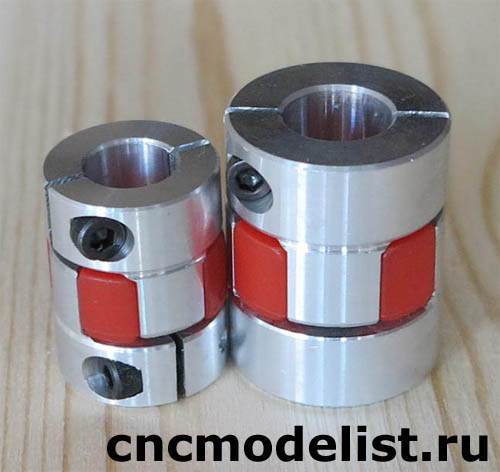
C) Choice of electronics
Electronics is presented (see fig. 1 and 2):
7 - stepper motor controller
8 - power supply of the stepper motor controller
11 - stepper motors
There are 4-wire, 6-wire and 8-wire stepper motors . All of them can be used. In most modern controllers, the connection is carried out using a four-wire circuit. The rest of the conductors are not used.
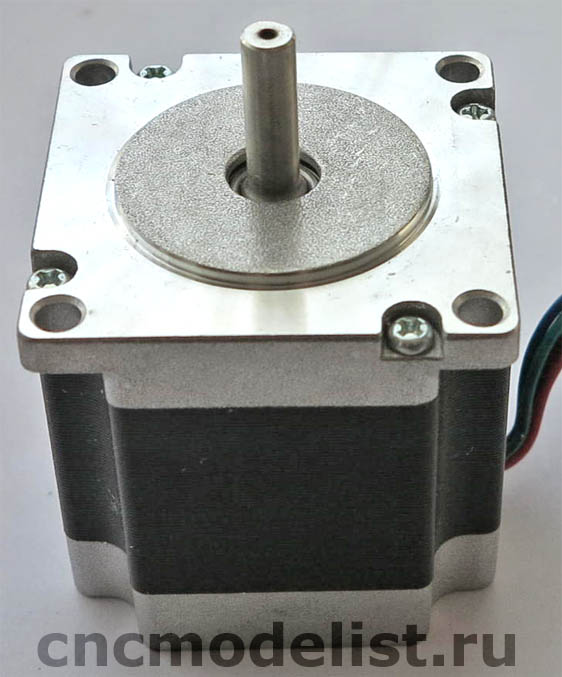
When choosing a machine, it is important that the stepper motor has sufficient power to move the working tool without losing steps, that is, without gaps. The larger the screw thread pitch, the more powerful motors will be required. Usually, the greater the current of the motor, the greater its torque (power).
Many motors have 8 outputs for each half winding separately - this allows you to connect a motor with windings connected in series or in parallel. With windings connected in parallel, you will need a driver with twice the current as with series-connected windings, but half the voltage will be enough.
With series, on the contrary - to achieve the rated torque, half the current will be required, but to achieve maximum speed, twice the voltage will be required.
The amount of movement per step is typically 1.8 degrees.
For 1.8, you get 200 steps per full turn. Accordingly, to calculate the number of steps per mm ( "Steps per mm" (Step per mm)) we use the formula: number of steps per revolution / screw pitch. For a screw with a pitch of 2mm, we get: 200/2=100 pitches/mm.
Controller selection
1) DSP controllers. Advantages - the ability to select ports (LPT, USB, Ethernet) and the independence of the frequencies of STEP and DIR signals from work operating system. Disadvantages - high price (from 10,000 rubles).
2) Controllers from Chinese manufacturers for amateur machine tools. Advantages - low price (from 2500 rubles). The disadvantage is the increased requirements for the stability of the operating system, it requires compliance with certain configuration rules, it is preferable to use a dedicated computer, only LPT versions are available.
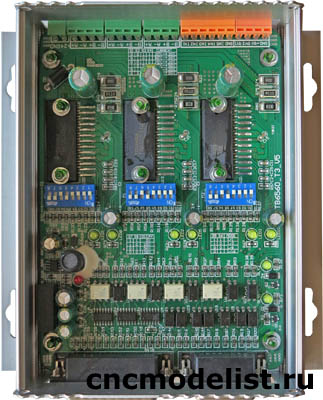
3) Amateur designs of controllers on discrete elements. The low price of Chinese controllers is crowding out amateur designs.
The most widespread in amateur machine designs are Chinese controllers.
Selecting a power supply
Nema17 motors require at least 150W power supply
Nema23 motors require at least 200W power supply
CNC can confuse you - there is so much variety in the industrial tool market.
Only many years of experience and specific knowledge allow specialists to select CNC machines in accordance with the requirements for equipment.
Many are simply lost in this abundance, and this is not surprising - it can be difficult even for professionals to choose the best CNC machine if they do not follow the latest tools on the market, the range of which is constantly expanding and improving.
It depends on what it will be used for. From materials, work profile, required speed and accuracy, from the required resource. Many significant characteristics of such machines directly depend on their equipment - on the properties of their components and consumables, on design features. Let's consider the most basic ones.What are the criteria for choosing a CNC machine?
The spindle is one of the main parts of the milling machine. It depends on the spindle which cutters can be used with this particular machine, at what angles they can be fixed and how exactly to use. The spindle drive is usually mounted - that is, the spindle is a powerful compact electric motor with a collet for clamping the cutter.
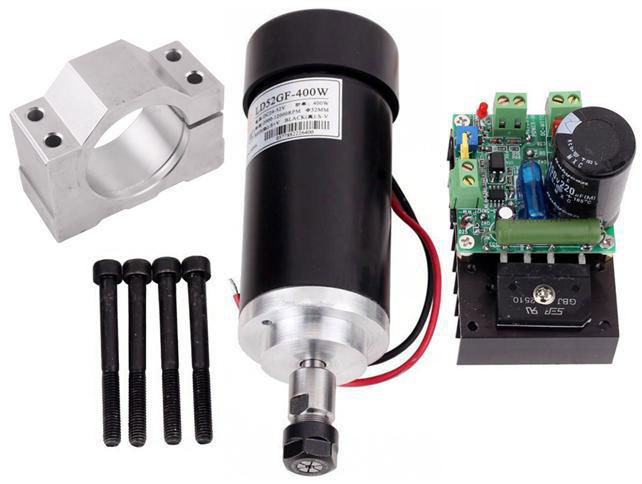
Much directly depends on the quality of the spindle - a good spindle will last a long time, constantly delighting you with the quality of work, while a bad one can ruin not only the product, but also damage the machine itself in the event of an accident, or even injure personnel. The choice of a spindle should be approached responsibly, always carefully listening to the recommendations of the machine manufacturer and paying attention primarily to the products of well-known and reputable manufacturers of components.
This is one of the most important characteristics of a CNC machine - the size of the milling area determines what size of the product the machine can process. Each narrow application has its own dimensional requirements, more than universal machines have an adjustable milling area, or obviously exceed the requirements for most common application cases.Milling area
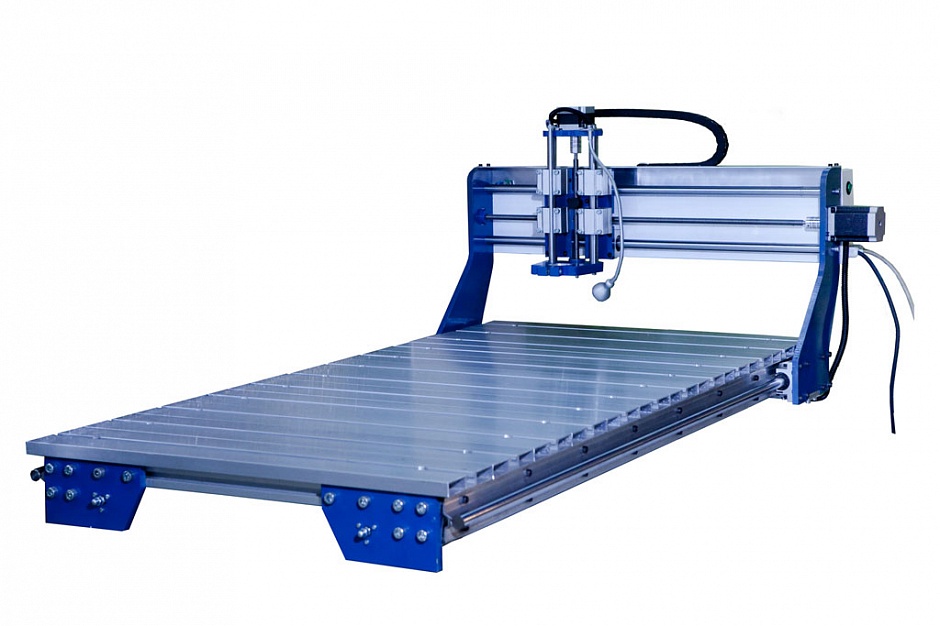
The arrangement of the platform is also important - fixing and precise positioning of the workpiece part should not cause difficulties, otherwise a serious marriage is possible. When choosing a CNC milling machine for work, it is necessary to determine in advance the dimensions of the workpieces so as not to get into a mess.
CNC machines are divided primarily by the material that they are designed to process, as well as by area of application.Purpose of the machine
The entered data on the dimensions and shape of the part become control trajectories in them, which, in turn, turn into control programs in the post-processing process.
A postprocessor is a special software product that converts data about the parameters of a part into an individual program, motion control tool and / or workpiece, for each specific machine.Postprocessor
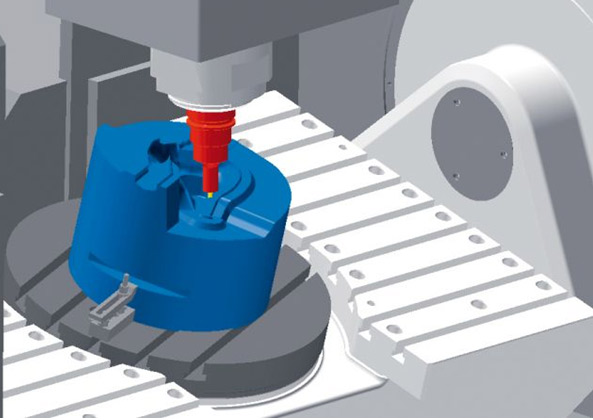
Here you can read more about the development of kinematic models, for example industrial systems from Siemens.
Detailed information on working with each specific machine can be obtained on the official website of its manufacturer. This is the most reliable option that will save you from many mistakes.
Control panel for one of CNC milling- machine tools:
Depending on the specifics of the work - on the material, the necessary forms of processing and other factors, in milling CNC machines used a large number of all kinds of cutters. Mills are single-thread, double-thread, spherical, v-shaped, conical spherical, pyramidal radius with one or two cutting edges, engraving, cutting, etc.Used cutters
Spherical and pyramidal cutters are used for deep material selection from a part, processing corners, creating recesses of the appropriate shape. Cutting and engraving cutters of various shapes are used for engraving, cutting a part, processing the edges of a product, and for shaping - creating a bas-relief image. Radius and fillet cutters, both convex and concave, are used for processing corners, edges of tabletops and other parts, chamfering, etc. End mills allow you to create holes, unlike drills - any shape.
Examples of cutters used:
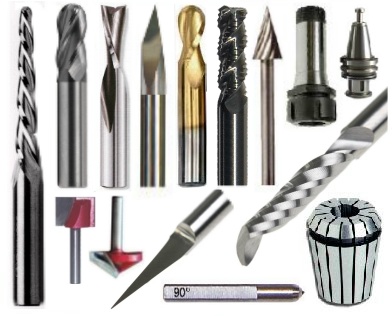
The variety of cutters varies from the simplest, similar to an ordinary drill or drill, to very complex ones, made of different materials and all kinds of shapes, with a different number of cutting edges. This provides a wide range of tasks they can solve.
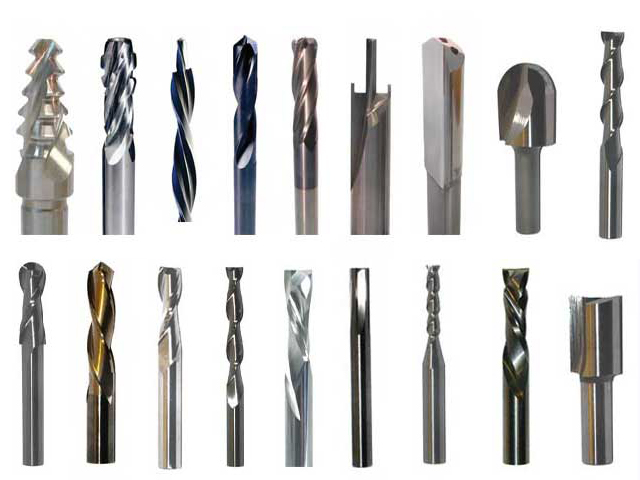
For each material and type of work, an individual selection of cutters is required, which our specialist will help you choose.
CNC milling machines are a wonderful tool that, when used correctly, can create a very wide range of products, from advertising structures to other machine parts, from kitchen cutting boards to aircraft jet engine parts. The scope of their application is almost limitless, and the range and degree of availability are increasing every day.
Now not only machine building plant can afford such equipment, but also a relatively small workshop, which is good news.
If you need advice on choosing a CNC machine - remember that you can always contact Top 3D Shop!
Do you want more interesting news from the world of 3D technologies?
Have you repeatedly wanted to know the possibilities of a CNC milling machine? Before you start looking for such a machine for your purposes, you need to determine what exactly you will use it for. Size and Functions of CNC Milling Machine for Machining various materials may differ significantly, but in general they are similar for all types of machines.
First of all, you need to determine the size of the machine and make sure that there is enough space for it in the room (workshop or workshop). Then you need to study the latest news in the world of CNC and make sure that the machine you buy corresponds to all the innovations (only if it is important and not financially critical).
One of the significant factors influencing the choice of CNC milling machine is the cost of purchase and installation. CNC, which stands for "Computer Numerical Control", is the process of controlling the machine with the help of computer program. In the recent past, quality machines were very expensive, but now their price has dropped significantly.
Before purchasing, be sure to find out about the accuracy of the purchased machine and its speed, as well as how their change will affect the cost.
Faster machines that can cut and mill to a certain tolerance will cost more, while slower, smaller, less accurate machines will cost less. For amateur purposes or a home workshop, a low-speed machine is enough, but for professional use, in order to cope with the entire workload, it is better to opt for an automatic machine with high processing speed and high accuracy.
Classification of CNC milling machines
The classification of CNC milling machines is quite different. Some models of machine tools will differ in design, namely, the ability of a CNC milling machine to independently change the tool. This function allows the machine, by selecting according to the program, to replace the working tool (milling cutter) without human intervention. The machine knows which cutter should be selected and used for certain tasks, which allows continuous processing of the workpiece without stopping.
Cheaper machines need to manually change the cutting tool, which adds work to the operator and slows down the whole process. The machine cuts edges and even shapes inside the workpiece, where tool changes are difficult, with the help of fast-rotating milling cutters mounted on the engine. Manual replacement of the working tool will require constant attention to the process.
Other features to consider when choosing a CNC router are:
- spindle cooling system (air or liquid);
- a wide platform on which you can easily fix the part for milling;
- high quality frame materials such as steel and aluminium;
- easy to use CNC Programs.
Which CNC router to choose based on such features?
One of the very useful options for a milling machine is a dust collection and removal system (exhaust), which removes dust directly from the cutting site, which allows you to keep your work area clean. The dust collection system will prevent the accumulation of small particles in the air, thus avoiding breathing problems, poor visibility, etc.
How to choose the right CNC machine
There are many types and manufacturers of CNC machines. When buying a new or used (used) CNC machine, there are a number of key features to look out for.

The figure shows a simple design of a CNC milling machine, it consists of the following parts:
- X axis;
- Y axis;
- Z axis;
- X axis drive;
- Y axis drive;
- Desktop;
- Spindle;
- Cartridge for installation of the cutting tool;
- Machine body (in this case aluminum).
Consider the most important characteristics of the machine:
Number of axles
This is the most fundamental quality of any CNC machine. In most basic designs, the cutting head moves in three directions - X, Y, and Z - and the tool itself is always pointing down and aligned with the Z axis. This design is a little limited compared to multi-directional machines containing a fourth and even fifth axis.
The material from which the machine is made
Cast iron or steel construction provides more high level rigidity and the ability to produce even the largest working space but is very heavy. If moving the machine around the workshop is not planned, then this option is optimal, but if frequent rearrangements are planned, then it is better to pay attention to machines made of aluminum, they are much lighter, and practically as strong as steel ones.
In the event that you will process soft materials and the machine will not experience heavy loads during operation, then you can make a choice in the direction of the design of polymer materials(acrylic, PVC).
Using a dedicated spindle
The spindle that connects the motor and the rotating tool provides big influence on the accuracy of the CNC machine. Its main task is to ensure that the rotation of the tool is concentrated in one point, has a minimum of vibration, and that these conditions are met even at maximum load.

A higher quality spindle improves accuracy by reducing the total amount of side to side oscillation and also reduces the difference between the intended and actual tool diameter.
For non-ferrous metals, wood, plastics and similar materials, a high spindle speed is recommended. When cutting soft materials at low spindle speeds, the flutes in end mills will become clogged with chips and ruin the part. The only way avoid gumming cutters in soft materials at low spindle speeds, this is to reduce the feed rate.
Ranges of mechanical movement
Large tool travel ranges allow you to process a large area of the workpiece in one pass. To determine the dimensions of the machine that you need, consider the maximum size of the products with which you are going to produce on it.
Travel speeds
There are many factors that affect the amount of time it takes to machine a particular workpiece, but the main one is always the performance of the CNC machine itself. “Why not do the processing at maximum speed?” - you ask. As already mentioned above, high movement speed does not always have a positive effect on quality finished products. For example, acrylic, at a high feed rate, begins to melt and deform, the wood is charred, this has a bad effect on the working tool, the cutters also “burn”.
If you are wondering: “How to choose a CNC milling machine?”, Then it is very important to pay attention to the maximum speed of movement if it is used for non-amateur purposes.
Stepper motor or servo: advantages and disadvantages
The types of drive motors for each of the axes are divided into stepper motors and servo drives.
Servo drives have higher accuracy compared to stepper drives and are much more expensive. The main advantage of the servo system is that it checks its position with each movement relative to an independent measuring device - a glass scale. This is a whole complex.

Servo
Stepper motors are open loop systems that execute a chain of commands without checking the position relative to the measuring device.

stepper motor
Definitely, servos are more accurate, but stepper motors do not add a very large error in operation. The choice between a servo and a stepping system only depends on how precise the end product needs to be.
If you are just starting your own business and have no experience in this area, choosing a CNC can confuse you - there is so much variety in the market for industrial tools. Only many years of experience and specific knowledge allow specialists to select CNC machines in accordance with the requirements for equipment. Many are simply lost in this abundance, search engines are overflowing with queries like “choice”, “cnc milling choice”, “choose a milling machine” and “choice of a cnc milling machine”. This is not surprising - it can be difficult even for professionals to choose the best CNC machine if they do not follow the latest tool market, the range of which is constantly expanding and improving.

What are the criteria for choosing a CNC machine? It depends on what it will be used for. From materials, work profile, required speed and accuracy, from the required resource. Many significant characteristics of such machines directly depend on their equipment - on the properties of their components and consumables, on design features. Let's consider the most basic ones.
Spindle
The spindle is one of the main parts of the milling machine. It depends on the spindle which cutters can be used with this particular machine, at what angles they can be fixed and how exactly to use. The spindle drive is usually mounted - that is, the spindle is a powerful compact electric motor with a collet for clamping the cutter.

Much directly depends on the quality of the spindle - a good spindle will last a long time, constantly delighting you with the quality of work, while a bad one can ruin not only the product, but also damage the machine itself in the event of an accident, or even injure personnel. The choice of a spindle should be approached responsibly, always carefully listening to the recommendations of the machine manufacturer and paying attention primarily to the products of well-known and reputable manufacturers of components.
Milling area
This is one of the most important characteristics of a CNC machine - the size of the milling area determines what size of the product the machine can process. Each narrow application has its own size requirements, more versatile machines have an adjustable milling area, or obviously exceed the requirements for most common applications.

The arrangement of the platform is also important - fixing and precise positioning of the workpiece part should not cause difficulties, otherwise a serious marriage is possible.
When choosing a CNC milling machine for work, it is necessary to determine in advance the dimensions of the workpieces so as not to get into a mess.
Types of machines
All CNC machines are divided primarily by the material that they are designed to process, as well as by scope. Then - by design features and novelty of design. The separation is quite simple and, with due diligence and desire, having studied several specialized resources and having decided on the budget, it will not be difficult to choose a CNC machine.
CNC metalworking machines differ from others primarily in the strength and power of the design, which allow them to work with metal as well as with most other materials.
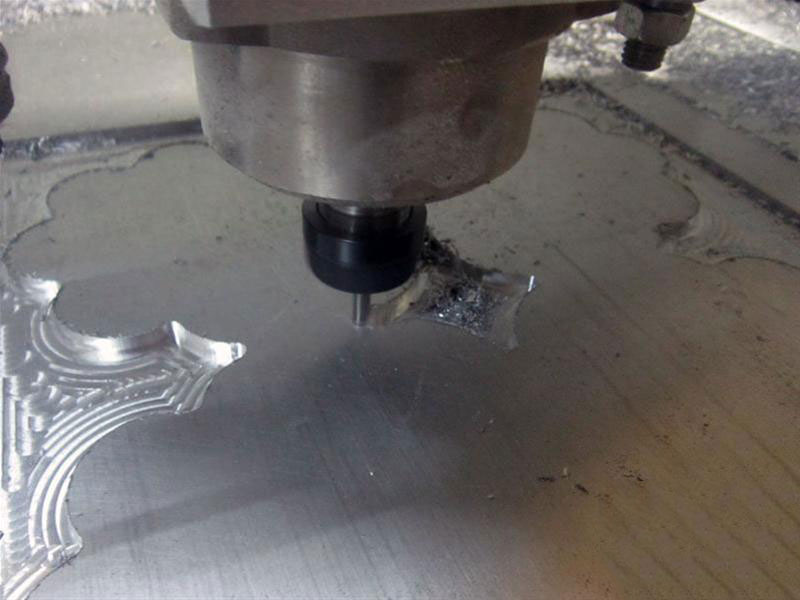
To reduce wear and avoid jamming of the cutter, they are often equipped with a coolant supply to the cutter, usually water or oil, directly to the working contact area, and many of them are equipped with powerful air suction - a structurally designed fastening of the socket of an industrial vacuum cleaner, to automatically remove chips from the workpiece. surfaces.
CNC machines for working with wood, as well as composites and plastic, structurally differ little from machines for working with metal, but have a little more simple design and lower requirements for power and strength characteristics, which is naturally due to the specifics of the material.
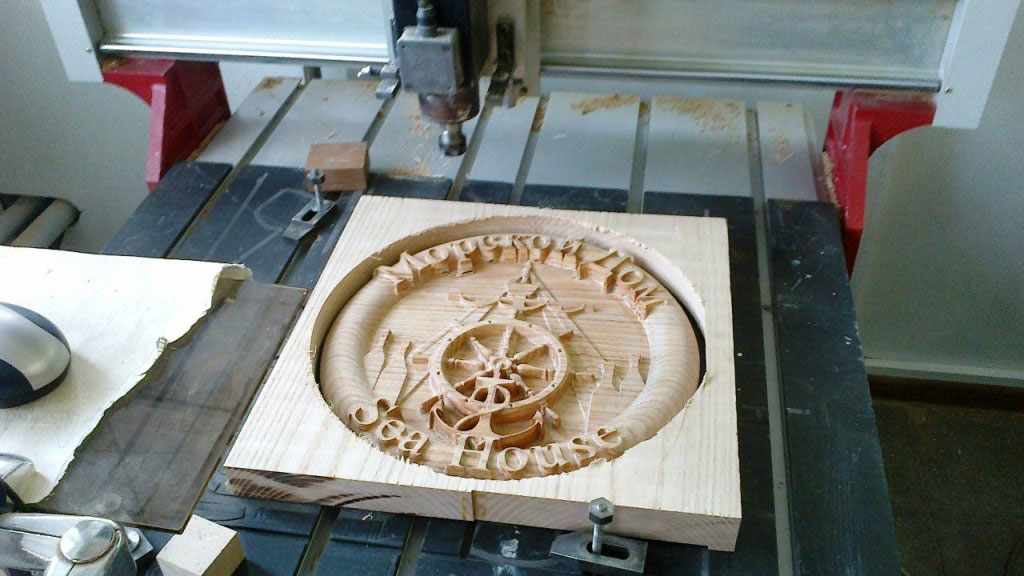
The cooling of the cutter in them is found in air, and more often it is completely absent, since its presence is not critical. Chip removal is also usually not provided and is carried out manually by the operator. Accordingly, the cost of such machines is usually somewhat lower, and their maintenance is simpler and cheaper, and their prevalence is greater.
Equipment for the production of cabinet furniture
CNC machines designed for the production of cabinet furniture have their own characteristics - in particular, the dimensions of the milling area in them exceed those of other CNC milling machines, since the parts for processing may differ in a larger area compared to other areas of CNC application.

Accordingly, a furniture CNC machine will have larger dimensions in all dimensions, as well as greater complexity and cost of the frame and rails, than a similar machine for working with smaller objects. Otherwise, they differ little from machines for processing wood, plastic and composite materials.
Glass processing machines
CNC glass-working milling machines differ from metal-working machines mainly in that they use special cutters with hard-alloy, diamond and corundum working surfaces. Cutters are both with a special coating and all-sintered - such components are created by baking diamond chips at high temperatures and high pressure, which gives an unusually strong and durable tool. Also, in glass-processing machines, the supply of working fluid to the contact area of the cutter with the material is mandatory - this is due not only to the need to cool the cutter when working with such a hard material as glass, but also to the obligation to immediately eliminate waste material fragments - so that they do not interfere further work and do not spoil the part, getting again into the place of contact of the cutter with the workpiece, on the one hand, and so that they do not get into the air that the machine operator breathes. In addition to glass, such machines can process polycarbonate, plexiglass different composition and other hard materials, as well as metal blanks.

You can choose a CNC machine for working on glass based on its compliance with these mandatory criteria.
Stone processing equipment
CNC milling machines for working on stone are designed for engraving and making complex volumetric bas-reliefs on such hard materials as natural stone different breed- granite, marble, sandstone, as well as on artificial stone slabs made of granite chips with polymer. The specifics of working on stone involves both large areas of processing, and high hardness of the material, and increased weight of the workpieces. Also, the stone is characterized by the fact that, when working with it, there is a need at the same time for constant circulation of water in the working area, and for the removal of crumbs and dust with a vacuum cleaner - water alone does not save large fractions of dust, characteristic of mineral materials.
Such machines can easily handle other materials - from wood and PVC, to, often, even glass and metal, and therefore will be useful not only to manufacturers of stone products, but also to those whose professional interests are much broader.
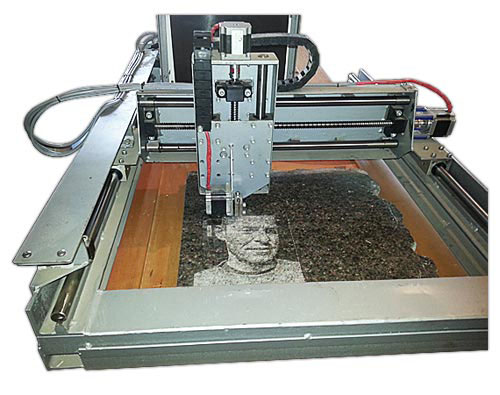
This is perhaps the most advanced equipment for milling with program control, which can do almost everything in this area of production, however, it is overly powerful, bulky and expensive for most jobs not directly related to its intended purpose.
As tempting as it may be to get a truly versatile CNC router, if stoneworking isn't one of your tasks, consider acquiring something more specialized from the ones listed above.
These are perhaps the most basic points that you need to be aware of when choosing a CNC milling machine. And even if at first it seems that if you need to buy a CNC milling, the choice is not easy, everything is not so scary. In other articles, we will talk in more detail about the specifics of working with each type of CNC milling machine and their device, this can also help with the choice, so do not miss new publications.
Before choosing a suitable machine portal () for your hobby, think about how you will use this machine, as well as evaluate the size of your workshop and where you are going to put the portal. The amateur portal is smaller in size than professional counterparts, which will limit you in the size of the processed materials.You will also need to look at the software for the CNC portal. CNC (numerical program control) must be connected to a computer that has sufficient power to run the necessary programs. Some portals come with the computer when purchased, while others must be connected to the machine, which must be purchased separately. If you already have a CNC computer that you intend to use with the hobby portal, make sure that the computer meets the requirements of the machine and that the necessary software can be installed on this computer.
The portal is designed in such a way at once to cut off some material from a large piece of wood, metal, plastic or other materials. Before buying a portal, you need to decide which material you are going to process, as this determines which portal to choose. Some machine portals are suitable for carving a variety of materials, while others are suitable for processing only one type of material. The size of the working table and the height of the vertical stroke of the tool will show the maximum possible size of the material being processed. Make sure you buy a machine that will be able to accommodate and cut your intended hobby material.
Some CNC gantry models are designed to work on a workbench, while others are large and have their own stand or other support. Take measurements of your workspace to determine what design and size of portal will fit your workshop. Remember that the structure can take up a significant amount of space on the workbench, so you need to find a place to leave the portal when not in use. Floor models with their own stand will also take up a lot of space, so these portals are more suitable for large workshops.











Mixed Personality Disorder: Causes, Symptoms, Types and Treatments
GTA 4 control settings
FAQ on Smuggling in GTA Online
LSPDFR - welcome to the police
The huge map of Grand Theft Auto San Andreas and its secrets